Frequently asked questions - FAQ
General questions
Questions and answers
In the BASTA system, no substance information is generally registered, with the exception of a limited number of substances covered by declaration with information requirements.
Information about constituent substances is only presented in BASTA audits when the assessment and documentation are reviewed, read more about this in the BASTA criteria document.
To increase the exposure of the article to the people searching the database, it is recommended to fill in as much article information as possible and to upload the construction product declaration, safety data sheet and other relevant official information in connection with the registration.
BASTA's database is public and registered articles can be accessed view our public search function on our website. BASTA's website is bilingual (Swedish and English) and we have many users from countries outside of Sweden.
Many also use BASTA's open API to pull data from BASTA into their own systems and databases. In this way, the information about registered articles is shared automatically and digitally. This service is used, among other things, by contractors, building materials dealers and service companies.
Via BASTA's logbook service, contractors, municipalities and property companies search for registered articles to create logbooks of buildings under construction.
The logbooks are created, among other things, to certify buildings according to Miljöbyggnad or to gain better control over what is built into properties and facilities.
The annual fee for the BASTA system is based on the company's annual turnover and number of registered articles.
No, BASTA's database of assessed products is completely open for anyone to search. You can access the information through our digital tools:
- Public search function
- Logbook service
- Open API
Assessment and registration
Questions and answers
Two-component products to be registered in the BASTA system are handled as follows:
Case 1: If the two components are only sold together as ONE product, these must be handled as a assembled article. The assessment must be based on the concentration of substances in the individual article, i.e. the assessment is not be based on the content in the assembled articla. It is then the content of each component that must be assessed against the BASTA criteria. The product is registered as one article when registering in the BASTA system.
Case 2: If the two components are sold separately as DIFFERENT products, these are handled as two separate articles. The assessment is based on the concentration of substances in each product. It is then the content of each product that must be evaluated against the BASTA criteria. The components are registered as two different articles when registering in the BASTA system.
When classifying aerosols, according to ECHA Q&A 1456 (searchable here: https://echa.europa.eu/sv/support/qas), sometimes the product must be classified by taking into account the propellant gas and in some cases not.
Case 1: If the propellant remains in the container during use, only the contents of the liquid must be taken into account when classifying. In practice, this means that you have to recalculate the liquid contents of the total product to a "new product" where the propellant contents are excluded.
Case 2: If the propellant gas is completely or partially released from the container during use and is completely separated from the liquid, the product must first of all be classified with respect to the contents of the liquid (as case 1) but also take into account the separate contents of the propellant IF these are classified as health- or environmentally hazardous.
Case 3: If the propellant is released in whole or in part during use but is NOT separated from the liquid, then the entire content of the aerosol must be taken into account when classifying (ie levels are counted as a "regular" chemical product).
Introduction
On this page there is clarification regarding criterion H7 - Sensitising".
This page exists to facilitate the assessment of whether a product meets the criteria in the BASTA system or not.
See the introductory part in the criteria document on how goods are to be assessed and how levels are to be calculated.
Criterion H7.A Respiratory sensitisers - Category 1A (H334)
For respiratory sensitizing substances, there are not yet tests to evaluate whether a substance is a strong respiratory sensitizing “1A” (criterion H7.A). But Criterion H7.B means that products labeled with H334 do not meet the criterion.
Criterion H7.C Skin sensitisers - Category 1A (H317)
According to CLP, only pure substances and tested mixtures can be classified as highly allergenic in case of skin contact (Skin Sens. 1A).
Mixtures classified using the calculation method are classified as skin sensitizers (skin sens 1 (ie without A)), see table 3.4.3.4.2 from ECHA's "Guidance on the application of the CLP criteria": https://echa.europa.eu/ documents/10162/23036412/clp_en.pdf/58b5dc6d-ac2a-4910-9702-e9e1f5051cc5
This means that a chemical product that is required to be labeled with H317 because it contains a 1A substance (for example a preservative) and is classified based on the calculation method can fulfill the criterion H7.C. However, the product does not meet criterion H7.D.

